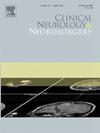Anatomical analysis of vertebral arteries in vertebrobasilar dolichoectasia: A multi-center study
IF 1.8
4区 医学
Q3 CLINICAL NEUROLOGY
引用次数: 0
Abstract
Background
Vertebrobasilar dolichoectasia (VBD) is a rare disease with significant morbidity. Its propensity for posterior circulation and relationship with aneurysms is poorly understood. Here, we aimed to describe the anatomical characteristics of the vertebral arteries (VA) in patients with VBD.
Methods
We conducted a multi-center retrospective cohort analysis on patients diagnosed with VBD between January 2009 and December 2022. Anatomical variables were measured after manual segmentation on CTA. Length of the VAs, basilar artery (BA), sectional diameters, and tortuosity index were measured and compared with a control group.
Results
124 patients were included: 38 patients with VBD and 86 controls. VBD patients had longer VAs (right VA 262.5 vs. 228.7 mm, p<0.01; left VA 253.4 vs. 222.1 mm, p<0.01), longer BAs (41.9 vs. 30.0 mm, p<0.01), and larger cross-sectional diameters of right V3 (5.1 vs. 4.6 mm, p<0.05) and V4 segments (4.5 vs.2.9 mm, p<0.05) and left V1-V4 segments (V1 6.1 vs. 4.2, V2 7.2 vs.4.8 mm, V3 6.4 vs.5.0 mm, V4 6.5 vs. 3.0 mm, p<0.01). Patients with VBD and fusiform aneurysms had longer VAs and BA than patients without aneurysms (p<0.01). The VAs tortuosity index was higher in VBD than controls (60.69 vs. 44.18, p<0.01). No cases of vertebral stenosis were detected.
Conclusions
Our study offers an anatomical study of VBD. While the natural history is poorly understood, the higher tortuosity index with associated wall shear stress, provides a possible mechanism for disease progression. Further studies are needed to better understand the
椎基底动脉扩张症患者椎动脉的解剖分析:一项多中心研究。
背景:椎基底动脉栓塞症(VBD)是一种罕见的疾病,发病率很高。人们对这种疾病的后循环倾向以及与动脉瘤的关系知之甚少。在此,我们旨在描述 VBD 患者椎动脉(VA)的解剖特征:我们对 2009 年 1 月至 2022 年 12 月期间确诊的 VBD 患者进行了多中心回顾性队列分析。在 CTA 上手动分割后测量了解剖变量。测量了VAs的长度、基底动脉(BA)、切面直径和迂曲指数,并与对照组进行了比较:结果:共纳入 124 名患者:结果:共纳入 124 名患者:38 名 VBD 患者和 86 名对照组患者。VBD患者的VA更长(右侧VA为262.5 mm对228.7 mm,p结论:我们的研究对 VBD 进行了解剖学研究。虽然对其自然病史了解甚少,但较高的迂曲指数和相关的管壁剪切应力为疾病的进展提供了可能的机制。还需要进一步研究,以更好地了解该疾病。
本文章由计算机程序翻译,如有差异,请以英文原文为准。
求助全文
约1分钟内获得全文
求助全文
来源期刊

Clinical Neurology and Neurosurgery
医学-临床神经学
CiteScore
3.70
自引率
5.30%
发文量
358
审稿时长
46 days
期刊介绍:
Clinical Neurology and Neurosurgery is devoted to publishing papers and reports on the clinical aspects of neurology and neurosurgery. It is an international forum for papers of high scientific standard that are of interest to Neurologists and Neurosurgeons world-wide.
 求助内容:
求助内容: 应助结果提醒方式:
应助结果提醒方式:


